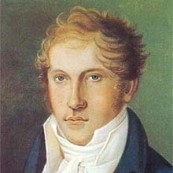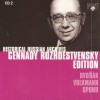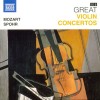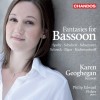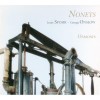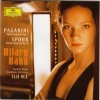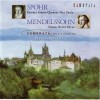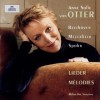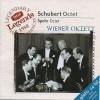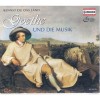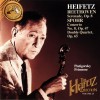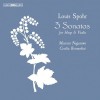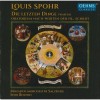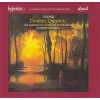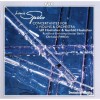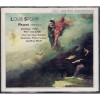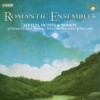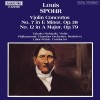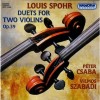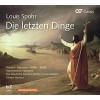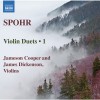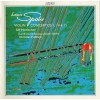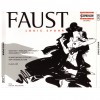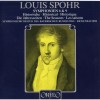| Country: | Germany |
| Period: | Romantique |
Biography
Louis Spohr (5 April 1784 – 22 October 1859) was a German composer, violinist and conductor. Born Ludewig Spohr, he is usually known by the French form of his name. Described by Dorothy Mayer as "The Forgotten Master", Spohr was once as famous as Beethoven. As a violinist, his virtuoso playing was admired by Queen Victoria. As a composer he ranks as a historic figure in the development of German music drama whose greatest triumph was in the oratorio. His orchestral writings and chamber works were once considered on a par with Mozart’s.
Spohr was born in Braunschweig in the duchy of Brunswick-Wolfenbüttel to Karl Heinrich Spohr and Juliane Ernestine Luise Henke. Spohr's first musical encouragement came from his parents: his mother was a gifted singer and pianist, and his father played the flute. A violinist named Dufour gave the lad his earliest violin teaching. The pupil's first attempts at composition date from the early 1790s. Dufour, recognizing the boy's musical talent, persuaded his parents to send him to Brunswick for further instruction.
The failure of his first concert tour, a badly planned venture to Hamburg in 1799, caused him to ask Duke Karl Wilhelm Ferdinand of Brunswick for financial help. A successful concert at the court impressed the duke so much that he engaged the 15-year old Spohr as a chamber musician. In 1802, through the good offices of the duke, he became the pupil of Franz Ignaz Beck and accompanied him on a concert tour which took him as far as St. Petersburg. Beck, who completely retrained Spohr in violin technique, was a product of the Mannheim school, and Spohr became its most prominent heir. Spohr's first notable compositions, including his First Violin Concerto, date from this time. After his return home, the duke granted him leave to make a concert tour of North Germany. A concert in Leipzig in December 1804 brought the influential music critic Friedrich Rochlitz "to his knees," not only because of Spohr's playing but also because of his compositions. This concert brought the young man overnight fame in the whole German-speaking world.
In 1805, Spohr got a job as concertmaster at the court of Gotha, where he stayed until 1812. There he met the 18-year-old harpist Dorette Scheidler, daughter of one of the court singers. They were married on February 2, 1806, and lived happily until Dorette's death 28 years later. They performed successfully together as a violin and harp duo (Spohr having composed the “Sonata in C minor for violin and harp” for her), touring in Italy (1816–1817), England (1820) and Paris (1821), but Dorette later abandoned her harpist's career and concentrated on raising their children.
In 1808, Spohr practiced with Beethoven at the latter's home, working on the Piano Trio Opus 70 No. 1, The Ghost. Spohr's writing indicates the piano was out of tune and that Beethoven's playing was harsh or careless, which has not been explained with certainty. Spohr later worked as conductor at the Theater an der Wien, Vienna (1813–1815), where he continued to be on friendly terms with Beethoven; subsequently he was opera director at Frankfurt (1817–1819) where he was able to stage his own operas — the first of which, Faust, had been rejected in Vienna. Spohr's longest post, from 1822 until his death in Kassel, was as the director of music at the court of Kassel, a position offered him on the suggestion of Carl Maria von Weber. In Kassel on 3 January 1836, he married his second wife, the 29-year-old Marianne Pfeiffer. She survived him by many years, living until 1892.
In 1851 the elector refused to sign the permit for Spohr's two months' leave of absence, to which he was entitled under his contract, and when the musician departed without the permit, a portion of his salary was deducted. In 1857 he was pensioned off, much against his own wish, and in the winter of the same year he broke his arm, an accident which put an end to his violin playing. Nevertheless he conducted his opera Jessonda at the fiftieth anniversary of the Prague Conservatorium in the following year, with all his old-time energy. In 1859 he died at Kassel.
Like Haydn, Mozart, Beethoven, and his own slightly older contemporary Johann Nepomuk Hummel, Spohr was an active Freemason. He was also active as a violin instructor throughout his career. His notable pupils included violinists Henry Blagrove and Henry Holmes.
A prolific composer, Spohr produced more than 150 works with opus numbers, in addition to a number of works without such numbers. He wrote music in all genres. His nine symphonies (a tenth was completed, but withdrawn) show a progress from the classical style of his predecessors to the program music of the ninth symphony, Die Jahreszeiten (The Seasons). Between 1803 and 1844 Spohr wrote more violin concertos than any other composer of the time, eighteen in all, including works left unpublished at his death. Some of them are formally unconventional, such as the one-movement Concerto No. 8, which is in the style of an operatic aria, and which is still periodically revived (Jascha Heifetz championed it), most recently in a 2006 recording by Hilary Hahn. There are two double-violin concertos as well. Better known today, however, are the four clarinet concertos, all written for the virtuoso Johann Simon Hermstedt, which have established a secure place in clarinettists' repertoire.
Among Spohr's chamber music is a series of no fewer than 36 string quartets, as well as four double quartets for two string quartets. He also wrote an assortment of other quartets, duos, trios, quintets and sextets, an octet and a nonet, works for solo violin and for solo harp, and works for violin and harp to be played by him and his wife together.
Though obscure today, Spohr's operas Faust (1816), Zemire und Azor (1819) and Jessonda (1823) remained in the popular repertoire through the 19th century and well into the 20th when Jessonda was banned by the Nazis because it depicted a European hero in love with an Indian princess. Spohr also wrote dozens of songs, many of them collected as Deutsche Lieder (German Songs), as well as a mass and other choral works. His oratorios, particularly Die letzten Dinge (The Last Judgement) (1825—1826), were greatly admired during the 19th century. During the Victorian era Gilbert and Sullivan mentioned him in Act 2 of The Mikado in a song by the title character.
Spohr, with his fifteen violin concertos, won for himself a conspicuous place in the musical literature of the nineteenth century. He endeavored (without any good result) to make the concerto a substantial and superior composition free from the artificial bravura of the time. He achieved a new romantic mode of expression. The weaker sides of Spohr’s violin compositions are observed in his somewhat monotonous rhythmic structures; in his rejection of certain piquant bowing styles, and artificial harmonics; and in the deficiency of contrapuntal textures.
Spohr was a noted violinist, and invented the violin chinrest, about 1820. He was also a significant conductor, being one of the first to use a baton and also inventing rehearsal letters, which are placed periodically throughout a piece of sheet music so that a conductor may save time by asking the orchestra or singers to start playing "from letter C", for example.
In addition to musical works, Spohr is remembered particularly for his Violinschule, a treatise on violin playing which codified many of the latest advances in violin technique, such as the use of spiccato. In addition, he wrote an entertaining and informative autobiography, published posthumously in 1860. A museum is devoted to his memory in Kassel.
According to Longyear, Spohr's best works were hailed by many of his contemporaries as quintessentially Romantic and inherited by Mendelssohn.





